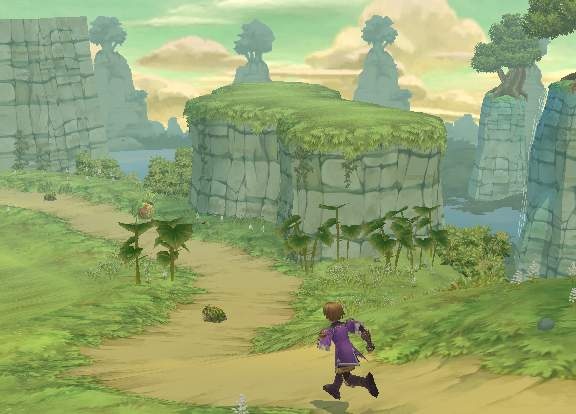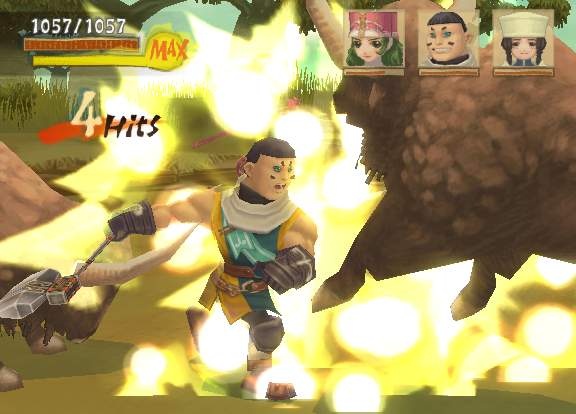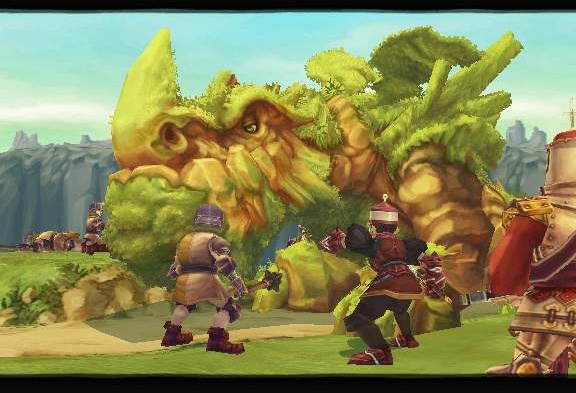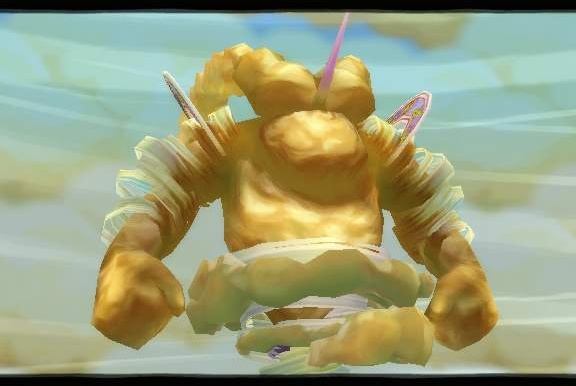Radiata Stories Preview
We got our hands on a US build of the latest role-playing game from Tri-Ace to see what the new world has to offer.
The developer of role-playing classics like Star Ocean and Valkyrie Profile is working on a PlayStation 2 exclusive to be published by Square Enix. This time around, Tri-Ace has created an entirely new universe, independent of its flagship Star Ocean franchise. Radiata Stories has been out in Japan since January, but we got our hands on a US build of the game to see what exactly the world of Radiata Stories has to offer.
Radiata is a bright, colorful fantasy kingdom where humans cohabitate with fairy creatures such as elves and dwarves. The races have an entirely perfunctory relationship, interacting with each other only to trade necessary resources. However, you soon see the fragile relationship between humans and fairy creatures dissolve as the races become embroiled in a bitter war for world dominance. Of course, it's up to you to cool tensions, end the war, and ultimately save the world for man--and fairy--kind.
You'll take part in these events by controlling Jack Russell, an excitable young man who also happens to be the son of a deceased legendary knight of the kingdom of Radiata. As the story begins, Jack is about to take the exam to become a Radiata Knight himself. Jack shows up and learns that he has to fight someone named Ridley Silverlake. Confident and eager as always, Jack declares that he will rip this Ridley guy apart. Jack is then surprised to find that Ridley is a woman, and he's even more surprised (and confused) when that woman promptly kicks his butt in a duel.

When the results of the test are announced, Ridley is accepted as a Radiata Knight, thanks to her extensive training and skills in combat. And, despite his lackluster performance during the test, Jack is also accepted as a knight, thanks to his father's legacy. This begins a fierce rivalry between the two young recruits that predictably develops into mutual affection as time passes and the two spend more time together. Jack and Ridley join the Rose Cochon Brigade under the command of Captain Ganz Rothschild, a well-intentioned, but too forgiving, knight who takes his duty very seriously.
Soon, the Rose Cochon Brigade receives their first assignment, which is to travel to the dwarven town of Earth Valley to escort precious cargo from the dwarven mines back to Radiata Kingdom. Before leaving, the party meets up with a priest, who comes along to provide support during the mission. The trip to Earth Valley just requires you to follow a linear path where a few small enemies get in the way, but they don't pose much of a threat. Once at Earth Valley, you are free to explore the town while the cargo is being prepared. When the cargo is ready the party heads back home. But on the way they are attacked by a trio of utterly stupid goblins. Once the goblins are defeated, the party returns to Radiata Castle and parts ways, and that's it for the first mission.
The next mission involves taking an important message to the elven City of Flowers, but first you have to persuade one of the elf lords to let you into the city. Before all this happens though, some blood orcs show up and attack an elf messenger. Jack is as feisty as ever and quick to take this opportunity to battle a more-challenging opponent. However, the orc proves to be too tough, and during battle Ridley is seriously injured and nearly dies. When they return to the castle, the Rose Cochon Brigade is disbanded for their failure, and both Jack and Ganz are discharged from the Radiata Knights. With nowhere else to go, Ganz suggests that they join Theater Vancoor, which is a warrior guild. Jack passes the test and joins up, but Ganz doesn't make the cut and the two part ways, at least for awhile.

All of these story sequences are told through frequent and very lengthy in-game cutscenes. These sequences occur often and involve several cuts, location changes, and copious amounts of dialogue, which is all fully voiced. We only played through the first several hours of the game, but we're told that eventually the storyline splits, allowing you to follow one of two distinct paths.
Fightin' Time
Between the story sequences, you do actually get to fight. As you move throughout certain parts of the world, you'll run into creatures that block your path. You'll be able to see these creatures, and they're usually easy to avoid. However, as is the standard in role-playing games, you'll want to engage in combat as often as possible to gain experience so that you'll be strong enough to defeat more-advanced enemies later in the game. The enemies we fought in the game ranged from tiny insects and huge mammals to machines and plants. When you contact an enemy on the map screen, a battle is initiated and you're taken to a large map where you can run around attacking enemies and helping allies.

By pressing the circle button you can perform a wide variety of attacks, depending on which abilities you have assigned. By successfully stringing together these attacks you fill up your volty gauge. Once your gauge reaches 10 volty points, you can perform a volty blow by pressing the square button. A volty blow does more damage and knocks your enemies back. If you max out your volty gauge, you can perform a special, even more-powerful volty break by pressing both the square and X buttons. Usually, the X button is used to make your character dodge attacks by quickly jumping back when an enemy is about to strike. In addition to attacking and defending, you can use items and issue commands to other members of your party.
Your party can consist of as many as four characters, three of which are controlled by the game's artificial intelligence. If you are the leader of the party, you can issue commands to your subordinates to get them to attack specific enemies or heal allies. There are more than 175 characters in the game that you can recruit to join your party. Before heading out on a mission, you can create a custom party of any of the characters on your friends list. Some characters show up on your list automatically, and others show up only after you help them out or trigger certain events.
In addition to the people on your friends list, the world is filled with non-playable characters with whom you can interact. You can talk to them as in any role-playing game, or you can walk up and give them a sharp kick to the shins. If you kick a character more than once, you'll be drawn into a battle. At one point, we kicked a princess and were quickly beaten down by a dozen guards. Luckily, when you are beaten this way you don't get a game over, but you're left with only one hit point. It's interesting to be able to fight any character in the game, especially since many of the them turn out to be quite strong. In addition to starting fights, kicking objects can reveal hidden items.

Whether you're on the battlefield or kicking about town, time will pass in a night and day cycle similar to the cycles in games like Majora's Mask, Grand Theft Auto, and Animal Crossing. Some events occur at specific times, so you'll often be waiting around until a cutscene is triggered to initiate your next task. While having a clock in an RPG is an interesting idea, it doesn't feel like you have to be too concerned with it in Radiata Stories. If you want to pass time quickly, you can just sleep until the next event occurs.
As soon as you start up Radiata Stories it will be apparent that the visual style of the game has been heavily influenced by Radiata's cousins, Valkyrie Profile and Star Ocean. The characters are very animelike, with huge eyes and disproportionate bodies. The characters are hilariously expressive, with flailing arms, stomping feet, and a variety of facial expressions. And since it's a Japanese role-playing game, you can count on seeing plenty of completely overblown swords and magic effects.
The world in Radiata Stories looks like something from a storybook, with pastel colors and detailed backgrounds that seem to stretch off into the distance. In fact, you'll often see creatures roaming around in the background or foreground, and you'll often want to stop and just enjoy the scenery. The little things also help bring the world to life, from the tiny bugs floating around in the air, to the dead leaves getting kicked up beneath your feet as you run through a shadowy forest. The game is definitely not trying to get too realistic with the art style, and due to the often silly, lighthearted tone of the game, the style feels in sync with the subject matter.

The soundtrack of the game consists of a bunch of upbeat, generic tunes that stay out of the way of the story rather than punctuating it. The voice work is fairly well done, and each voice seems to fit its respective character. However, during battles the characters will constantly shout out catchphrases like "Alright!" These phrases are often repeated more than a dozen times in a single battle, which could get old quickly.
Radiata Stories looks like it could be an intriguing role-playing experience, if only for the vibrant, fairy tale setting. Tri-Ace isn't straying too far from the path on this one, but that will please fans just fine. Be sure to check back in September when we'll bring you our full review.
Got a news tip or want to contact us directly? Email news@gamespot.com
Join the conversation